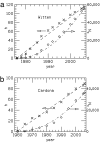Does the H index have predictive power?
- PMID: 18040045
- PMCID: PMC2148266
- DOI: 10.1073/pnas.0707962104
Does the H index have predictive power?
Abstract
Bibliometric measures of individual scientific achievement are of particular interest if they can be used to predict future achievement. Here we report results of an empirical study of the predictive power of the h index compared with other indicators. Our findings indicate that the h index is better than other indicators considered (total citation count, citations per paper, and total paper count) in predicting future scientific achievement. We discuss reasons for the superiority of the h index.
Conflict of interest statement
The author declares no conflict of interest.
Figures











References
-
- Lehmann S, Jackson AD, Lautrup BE. 2007. http://arxiv.org/abs/physics/0701311.
-
- Lehmann S, Jackson AD, Lautrup BE. Nature. 2006;444:1003–1004. - PubMed
-
- Egghe L. Scientometrics. 2006;69:131–152.
-
- Jin B-H, Liang L-M, Rousseau R, Egghe L. Chin Sci Bull. 2007;52:855–863.
MeSH terms
LinkOut - more resources
Full Text Sources

